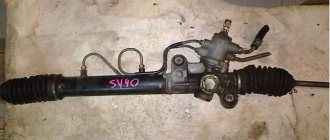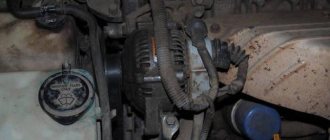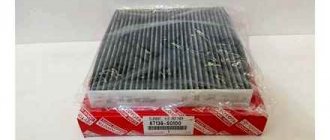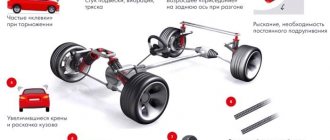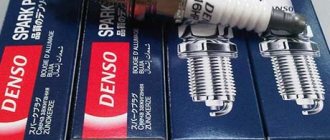Toyota Camry is a full-size sedan that can easily transport 3 adults and 1 child. For this purpose, the car is equipped with two rows of seats. The front 2 seats intended for the driver and passenger, depending on the configuration, can be equipped with side airbags.
The driver's seat is adjustable in height, length and tilt. The front passenger seat may have different settings, depending on the model and year of manufacture. The rear row of seats is made of a single element.
Why do you need to remove the second row of Camry?
To reupholster the interior, you will have to remove the rear sofa.
If the car is properly maintained, a similar procedure should be performed at least twice a year in preparation for the winter or summer season. Also, owners of Toyota Camry 40 have to remove the rear seats:
- when completely replacing the second row to update the interior;
- to increase the volume of the luggage compartment;
- during bodywork or painting work;
- if necessary, inspect and repair components and mechanisms located behind them.
The Camry fuel pump is located under the rear sofa of the Camry.
When you go to a service station for diagnostics and further repair of the mechanism, you can leave everything to the shoulders of the craftsmen. But they will include the removal of the seats in the cost of the work, and it doesn’t cost a penny during the service.
Experienced motorists advise periodically drying the Toyota interior if you often have to overcome water obstacles, that is, puddles, drive in damp weather and store the car in a damp room. And to do this you need to remove the back sofa.
In addition to the indicated reasons for dismantling the second row, Camry seats are also removed when additional sound insulation is performed. During this procedure, the chairs and backrests are removed, since access to the bottom is required.
What tools will you need?
To dismantle the second row of seats on a Toyota Camry, you will need the following kits:
- screwdriver;
- open-end wrenches;
- heads
While working, you may need pliers and long tongs.
Even for an inexperienced motorist, removing the second row of seats will take no more than 2 hours. During operation, only disposable plastic clips can be damaged. Therefore, to save time and money, you can perform the procedure yourself, without the help of a car mechanic.
Remove the front row of seats.
The work takes place in several stages:
- The car is installed on a horizontal platform. A lift or inspection hole is not required. Unobstructed access through doors must be ensured. Disconnect the battery.
- The seat backs move to a vertical position, after which we move them forward as much as possible, towards the panel.
- The decorative trims are removed, after which the mounting bolts on the slide are unscrewed with a “14” head.
- The wires going to the airbags and heated seats are disconnected. It is not recommended to start the engine if the heating terminals are disconnected in order to avoid the appearance of system errors on the BC.
Replacing seats for Toyota Camry 40
- the car is in transport position. There is no need to use an inspection channel or a lift. The doors are wide open, providing access around the perimeter;
- We bring the driver’s seat to a vertical position and move it forward as far as possible;
- We remove the plastic pads from the back and use the “14” head to unscrew the two mounting bolts of the ski. Disconnect the seat heating contacts;
- in the front part we carry out similar actions, having previously moved the driver’s seat back;
- removed from the car interior. The front passenger seat is also dismantled by analogy;
- We install new ones or restore old ones, depending on the client’s wishes and the general condition of the elements. Often a complete reupholstery, replacement of foam rubber (pumping), and electric drive are required.
Only after complete installation and connection of the seat heating contact board is it possible to start the Camry 40 engine. If the specified algorithm is followed, the system error will not be identified.
Removing the driver's seat
How to remove the driver's seat of a Camry? In this case, the procedure is slightly different than when disassembling and removing the rear seats. It is required to perform certain operations sequentially:
- Remove the seat trim (on Camry 50, 40, 30)
- Remove the seat adjustment lever, first adjusting it so that the seat is in the highest position;
- Disassemble the seat. To do this, you need to dismantle the chair tilt adjustment handle, the glove box, remove the side bars, having first unscrewed the fixing bolts and removed the plugs;
- The V40 and V50 models are equipped with side airbags and a heating system. If these components are present, it is necessary to dismantle the corresponding blocks and carefully disconnect the wires;
- Disconnect the springs located below from the seat itself;
- Remove the height adjustment mechanism for the driver's seat, having first disconnected the 3 bolts securing it;
- Carefully remove the seat itself, lifting it up.
how to remove the back seat? — Toyota Camry Club Russia
Part 3. TOYOTA CAMRY Review. Back seat
This creates significant inconvenience for passengers. Dismantling the backs This process, of course, is not over yet. You don't even need the help of a specialist.
Toyota Corolla `08 Rear seat. Withdrawal. How to install covers on a Toyota Camry 50 (Toyota Camry...
The second important reason is repair or reupholstery.
By tilting the back as far forward as possible, the bolts will be visible at the bottom. Carefully, there is a red-black wire to the brake light on the right. The main stages of removing rear car seats The entire process can be divided into two stages, each of which will definitely play an important role during the event:
After this, you can unscrew the backs. On the back you will find fasteners. It is necessary to unscrew two bolts on the right and left sides of the backrest. In some cases, you may need to remove the seat belt from its guides.
What to do if the electric drive does not work.
First of all, you need to check the fuses. The operation of the seats is controlled by a 30 ampere fuse F, which is located in the interior mounting block. If the fuse is good, you need to check the operation of the drive by ear without starting the engine.
If you can hear the engine running, but the seat does not move, you need to check the condition of the drive. The chair needs to be disassembled.
If the motor itself does not make any sounds, then the voltage supply is checked. To do this, the control unit is removed and the buttons are checked using a tester.
If the control is working properly, you need to remove the motor and check by applying voltage to it directly. To do this, you can connect it to the battery using wires of sufficient length.
Defective components should be replaced with new ones. You can select the required part number using the vehicle's VIN code.
Adjustment and repair of the Toyota Camry electric seat adjustment mechanism.
A standard mechanical drive tuning system consists of 4 main components:
- Position adjustment lever,
- Cushion height adjustment lever,
- Handles for changing the backrest angle,
- Lumbar support adjustment lever.
Important to remember! When adjusting the position of the driver's and passenger's seats, do not allow the backrest to tip back too much. The vehicle's seat belts, especially the lumbar support, are configured to provide maximum effectiveness when the seatbacks are in an upright position.
If you are lying down on the floor, during an accident the lap belt can slip past your hips and severely injure the abdominal cavity.
The electrically adjustable seats are equipped with 3 function keys:
- Button for changing the longitudinal position of the seat and adjusting the height. This button moves in 4 directions. By moving it in the desired direction, you can adjust the position of the chair.
- Adjusting the back angle. Works in 2 directions. To lock the backrest in the desired position, simply release the lever.
- Lumbar support adjustment.
Removal stages
To dismantle the second row of car seats you must:
- empty the trunk to remove the floor covering;
- remove the armrests;
- unscrew the fixing bolts that secure the adjusters for the angle mechanisms of the car seats;
- remove the seat belts.
If dismantling is carried out for the purpose of installing additional sound insulation, it is necessary to remove the plastic elements that cover the holes in the trunk.
The seat and backrest of the rear sofa can be removed separately. First, the lower part of the chair is removed, then the top.
Toyota Camry rear seat removal
You need to pull sharply and strongly.
Removing the second row of seats using the same algorithm on all model lines of the Japanese concern would be a big mistake. After all, even between generations of Toyota there are differences in design and technical solutions, so it is better to clarify how to properly remove the rear seat of a Camry 40.
For the car in the fortieth body, they used a different design of the lower frame on the back, and they also have a different cable arrangement. The fastening parts are also screwed much deeper, which complicates their dismantling.
Folded rear row of Camry 50
You will first need to empty the luggage compartment to remove the floor covering. If there are armrests and a mechanism that regulates the angle of the backrest, they must also be removed first. To do this, simply unscrew the fixing bolts. All seat belt attachments are removed in the same way. When performing additional sound insulation, the plastic linings covering the opening into the luggage compartment are also removed.
You should know that the backs and the sofas themselves are removed separately. Most often, they begin to pull out the second row from the bottom, and then take it to the top if there are no design or fastening features.
Removing the seats
You can remove the sofa on the Toyota Camry v50 using a slotted screwdriver and a ratchet wrench size 12. Armed with the necessary tools, first:
- You should pull the edges of the pillow to release the fastening loops;
- Disconnect 2 connectors with a slotted screwdriver;
- Now the seats can be pulled out of the cabin.
On the Camry XV40, you can do without a screwdriver, just lift the sofa and pull to pull the staples out of the grooves.
If there are covers on the seats, you can leave them, but for convenience and to keep them clean, it is better to remove them.
Installing the sofa into the interior should be done in the reverse order. Only on the fortieth Camry you will have to make a little effort to get the staples into the grooves.
Removing the backrests
The procedure for dismantling the backrests takes a little longer. Here you will have to work more with a key of 12. So, we remove the backrests of the seats on the Camry 50, for which you need:
Do-it-yourself replacement of upholstery and cleaning of Toyota Camry ACV40 seats
The content of the article:
0:37
1. Replacing seat trim for Toyota Camry ACV40
0:107
2. Do-it-yourself cleaning of Toyota Camry ACV40 interior seats
0:201
Replacing seat trim for Toyota Camry ACV40
The leather driver's seat is a sore subject for Camrivods. Today we will tighten/change the original trim of the driver's seat saddle, but there is one BUT - the new trim that I managed to find was for the passenger seat (7107133D61B0). Accordingly, I assumed that it would be possible to put it on the driver’s seat, judging by the symmetry of the seats, and bought it, taking a chance. Although someone told me on the Internet that these are completely different details.
0:1094
1:1599
This is what an old saddle looks like!
1:1658
2:2163
Damn through hole
2:41
3:546
Well, then the parsing process itself, I warn you, I won’t go into detail because you can intuitively understand what’s what:
3:771
We unscrew the seat - it is attached to the floor with four screws (they were almost not tightened), disconnect the 3 connectors and drag it home.
3:1007
4:1512
Remove the seat control handles (they simply snap off).
4:1622
5:2127
Turn the seat over and unscrew the 4 screws that hold the plastic body.
5:154
6:659
And we begin to remove the upholstery by snapping off the white longitudinal fasteners from the seat skeleton.
6:819
7:1324
We twist the control unit (3 screws).
7:1396
8:1901
9:2406
Having freed the upholstery from all fastenings, it is removed along with the foam rubber.
9:130
10:635
Next, we need to separate the casing from the foam rubber, it is attached to ties that run under the seams, we simply bite them off.
10:858
11:1363
12:1868
We are also filming the rest.
12:1917
13:2422
Then we remove the guide spokes from the old casing and rearrange them into the new one.
13:149
14:654
We begin the assembly process in reverse order.
14:738
15:1243
16:1748
Now, in general, the very difference between the left and right seats is this cutout, which I made with a stationery knife.
16:1969
17:2474
Well, since I didn’t have threads and a needle, I used a stapler, which, in turn, easily pierced the leatherette with plastic that I threw from the old casing. There is a small piece under two white screws.
17:424
18:929
Next, we put the seat control unit back, connect the connectors, and screw the housing.
18:1097
19:1602
20:2107
21:504
We found out that it is still possible to pull the passenger upholstery over the driver's seat. As for wrinkles, this was my first time doing this. Maybe the foam sagged, maybe I missed something, but I assure you, I pulled as hard as I could. Let's see, we'll go for a ride, maybe I'll take it apart one more time.
21:967
22:1472
23:1977
Do-it-yourself cleaning of Toyota Camry ACV40 interior seats
24:2581
I decided to wash and polish the leather interior of my favorite car. I read a lot of material on this topic, what to do and with what materials. But everything I read was very expensive and I decided to take the path of less and economical resistance.
24:432
I came across a very interesting report where a man washed the interior with laundry soap. And I decided to do so.
24:643
1. I took an army waffle towel and cut it into four parts.
24:767
2. He poured water into a bucket and took the household items with him. soap. I soaped a rag, wrung it out so that the water would not flow, and thoroughly, but without fanaticism, wiped all the leather seats.
24:1037
3. Then I cleaned everything with a clean damp cloth.
24:1124
4. Let it dry.
24:1159
5. Sprayed pre-purchased Black Cat skin care product.
24:1278
6. Rub the seats until they shine.
24:1329
I was very pleased - the leather of the seats became soft and silky, and the smell was simply gorgeous. It feels like the interior has been treated with expensive men's cologne. I spent 1.5 hours and 109 UAH on this wonderful car leather care product for all the movements.
24:1815 25:2320 26:504 27:1009
https://www.drive2.ru/l/10144283/
27:1046
https://www.drive2.ru/l/452716766984929914/, https://www.drive2.ru/l/452718416252372331/
27:1138 next article:
Interior lighting Toyota Camry ACV40
Task: to provide footwell lighting for passengers and the driver in the Toyota Camry ACV40 interior. Footlight lighting for passengers on the Toyota Camry...
28:1947
Rating 0.00 [0 Vote(s)]
31458
How to remove the back seat on a Camry
The sequence of actions may differ slightly depending on the specific brand of car and, as a result, on its design features. In general, dismantling the rear seats consists of the following steps:
- Removing the front part of the trunk floor covering. To do this, you need to free this coating from the fasteners;
- Removing the rear seat backrest clamps, after which you need to unscrew the bolts and release the seat;
- Removing the armrests and dismantling the back angle control mechanism, dismantling the seat cushion. To do this, it must first be freed from the fixing bolts;
- Removing the cover from the pillow;
- Removing the seat belt anchor. This operation is carried out from the right rear seat. First you need to unscrew the fixing bolt;
- Disconnecting the cable, dismantling the seat back assembly kit;
- Removing the cover and armrest assembly kit;
- Unscrewing the fixing screws and removing the rear wall of the seat being removed;
- Dismantling the lever for removing the fixation of the seat being removed;
- Removing the armrest supports and seat belt cover. To do this, you also need to unscrew the corresponding fasteners;
- Removing the backrest from the frame;
- Removing the bracket and armrest cover from the frame;
- Removing the seat cushion cover;
- Removing the seat belt buckle;
- Dismantling the connecting rod with preliminary unscrewing of the bolts. This operation is carried out from the right seat;
- Removing the lower back frame.
Installing the rear seat is done in the reverse order.
How to remove the rear seat of a Toyota Camry V40? The sequence of actions is the same as in previous models, so there are no fundamental differences. The V40 has a slightly different design of the lower back frame, and the cable is located differently. The fasteners are recessed deeper, making them somewhat more difficult to remove.
Source
Seats Toyota Camry 1992-
- Repair manuals
- Repair manual for Toyota Camry 1992-1997.
- Seats
Repairing a car yourself remains a rather difficult task, especially if you consider the seats of a 1992 Toyota Camry. Today you can find a large number of various recommendations that tell you how to solve some problems during the operation of a particular car unit, but the bulk of such resources are based only on generalized information, without delving into the subtleties and details, on which not only the duration of operation, but also its effectiveness often depends.
Our information portal offers you full support in this matter. The presented repair manuals and detailed descriptions of the units are available online 24 hours a day. If necessary, you can get a more convenient, handy version by simply downloading it from the page. A detailed description of the parameters and what the Toyota Camry 1992 seats are made of, important aspects for correct and reliable installation will help to significantly reduce the risk of unexpected car breakdowns. Information provided about all components online allows you to quickly and effectively monitor any defects and defects, even before they appear during operation.
Most of the data presented on the site is taken from the instructions, but at the same time, it is much better structured and disclosed in detail to the user. Using them as an application database, you can always install and repair cars with your own hands, no less efficiently than in a car service center. But to do this you need to have a certain amount of knowledge, which can be replenished on our website.
Having studied all the necessary features of the unit, the car owner will gain invaluable experience in handling not only original, but also contract options. It's no secret that the original will in 100% of cases meet the assigned tasks as part of the car, but there is always a risk of manufacturing defects, which can be easily determined using our recommendations.
A good contract spare part is almost as good in quality and reliability as the original models. However, in most cases, important nuances remain during installation and operation, knowledge of which will help maintain the performance of the analogue at the proper level. Most sections of the site are devoted to these and many other important points.
15.18.1 Seats Front seat fastening elements PERFORMANCE ORDER 1. Unscrew the fastening bolts, disconnect the electrical connectors and remove the front seat from the car interior. 2. Installation is carried out in the reverse order of removal.
15.18.2 Rear seat Rear seat fastening elements PERFORMANCE ORDER 1. With a sharp upward movement, remove the rear seat cushion from the clamps, lift it and remove it from the car. 2. Unscrew the bolts securing the lower part of the rear seat back, lift the back up and ...
15.18.3 Rear seat of a folding type Fastening elements for a rear seat of a folding type PERFORMANCE ORDER 1. With a sharp upward movement, remove the front part of the rear seat cushion from the clamps and remove the rear seat cushion from the car interior. 2. Unscrew the bolts and remove the side panels...
↓ Comments ↓
1. Operating instructions
1.0 Operating instructions 1.2 Instrument cluster 1.3. Keys 1.4. Doors 1.5 Headrests 1.6. Seats 1.7 Setting the steering wheel height 1.8. Light switches, windshield wipers and direction indicators 1.9. Control devices 1.10. Indicator lamps 1.11 Econometer 1.12 Ignition switch 1.13. Automatic gearbox 1.14 Manual gearbox 1.15. Cruise control 1.16. Heating and ventilation system 1.17 Clock
2. Maintenance
2.0 Maintenance 2.2 Maintenance intervals
3. Four-cylinder engine
3.0 Four-cylinder engine 3.2 Engine repair operations on a car 3.3 Top dead center of the first cylinder 3.4. Cylinder head cover 3.5. Intake manifold 3.6. Exhaust manifold 3.7. Toothed belt and pulleys 3.8 Replacing the front crankshaft sealing ring 3.9 Replacing the camshaft sealing ring 3.10. Camshaft and pushers 3.11. Cylinder head 3.12. Oil pan 3.13. Oil pump 3.14. Flywheel / drive plate 3.15 Replacing the rear crankshaft sealing ring 3.16. Powertrain suspension
4. Six-cylinder V6 engines
4.0 Six-cylinder V6 engines 4.2 General information 4.3 Repairs that do not require engine removal 4.4. Top dead center (TDC) of the piston of the first cylinder is 4.5. Engine 3VZ-FE 4.6. Intake manifold 4.7 Exhaust manifold 4.8. Toothed belt and pulleys 4.9 Replacing the front crankshaft sealing ring 4.10 Replacing the camshaft sealing rings 4.11. Camshafts and pushers 4.12. Cylinder head 4.13. Oil pan 4.14. Oil pump 4.15 Flywheel/drive plate 4.16 Replacing rear crankshaft O-ring 4.17 Powertrain suspension
5. Engine overhaul
5.0 Overhaul of engines 5.2 General information 5.3 Compression check 5.4 Recommendations for engine removal 5.5. Removing and installing the engine 5.6 Engine disassembly sequence 5.7 Disassembling the cylinder head 5.8. Cleaning and inspection of the cylinder head 5.9 Assembling the cylinder head 5.10 Removing the pistons with connecting rods 5.11 Removing the crankshaft 5.12. Engine cylinder block 5.13 Pistons and connecting rods 5.14 Crankshaft 5.15. Inspection and selection of main and connecting rod bearings 5.16 Checking the play of the balancer assembly (5S-FE engine) 5.17 Sequence of engine assembly during a major overhaul 5.18 Installing piston rings 5.19. Installing the crankshaft and checking the working clearances of the bearings 5.20 Installing the rear sealing ring of the crankshaft 5.21 Installing the pistons and connecting rods, checking the working clearances of the bearings 5.22 Installing the balancer assembly (5S-FE engine) 5.23 Starting the engine after a major overhaul
6. Cooling, heating and air conditioning system
6.0 Cooling, heating and air conditioning system 6.2 General information 6.3 Antifreeze 6.4 Cooling system hoses 6.5. Checking and replacing the thermostat 6.6. Checking and replacing the radiator fan and relay 6.7. Radiator fan (V6 models from 1992 to 1994) 6.8. Radiator 6.9 Expansion tank 6.10. Water pump 6.11. Coolant temperature sensor 6.12 Heater fan 6.13 Heater fan resistor 6.14 Heater radiator 6.15. Heater control panel 6.16 Air conditioning system
7. Fuel system
7.0 Fuel system 7.2 General information 7.3 Relieving pressure in the fuel system 7.4. Checking the fuel pump 7.5 Fuel pump 7.6. Fuel level sensor 7.7 Fuel tank 7.8 Air filter 7.9. Accelerator cable 7.10 Electronic fuel injection system EFL 7.11. Fuel system 7.12 Checking the fuel injection system 7.13. Checking and replacing elements of the EFI fuel injection system 7.14 Fuel line and fuel injectors 7.15. Air conditioning idle speed valve 7.16 Air intake chamber (V6 engines only)
8. Ignition, starting and charging system
8.0 Ignition, starting and charging system 8.2 Battery 8.3. Ignition system 8.4. Checking the ignition system 8.5. Ignition coil 8.6. Ignition distributor 8.7 Checking and adjusting the ignition timing 8.8 Ignition unit (switch) 8.9. Pulse sensor 8.10 Charging system 8.11 Generator 8.12 Checking and replacing generator components 8.13 Engine starting system 8.14 Starter 8.15 Traction relay
9. Emission control and engine management system
9.0 Exhaust emission control and engine control system 9.2 General information 9.3 Electronic control system (TCCS) 9.4 Self-diagnosis system 9.5. Sensors 9.6. Engine air induction system (ACIS) 9.7 Evaporative vapor recovery system (EVAP) 9.8. Exhaust Gas Recombustion (EGR) System 9.9 Crankcase Ventilation (PCV) System 9.10 Catalyst 9.11 Fault Codes
10. Manual transmission
10.0 Manual transmission 10.2 General information 10.3 Gear shift cables 10.4 Gear shift lever 10.5 Reverse light switch 10.6. Removing and installing the gearbox 10.7 Repairing the gearbox
11. Automatic transmission
11.0 Automatic transmission 11.2 General information 11.3. Diagnostics 11.4. Adjusting and replacing the gear selection cable 11.5 Checking and adjusting the throttle control cable 11.6. Checking, replacing and adjusting the starter interlock switch 11.7. Gear selection lever lock 11.8. Replacing sealing rings 11.9. Checking and replacing gearbox supports 11.10 Electronic control system
12. Clutch and drive shafts
12.0 Clutch and drive shafts 12.2 General information 12.3. Checking and replacing the clutch disc 12.4. Release bearing 12.5. Clutch master cylinder 12.6. Clutch slave cylinder 12.7 Bleeding air from the clutch hydraulic system 12.8 Clutch start switch 12.9. Constant velocity joint (CV joint) 12.10 Replacement of protective covers and repair of constant velocity joints 12.10. Models with 5S-FE engine
13. Brake system
13.0 Brake system 13.2 General information 13.3 (ABS) 13.4 Replacing disc brake pads 13.5. Disc brake caliper 13.6. Brake disc 13.7 Replacing brake pads on drum brakes 13.8. Working brake cylinder 13.9. Main brake cylinder 13.10 Brake lines and hoses 13.11 Bleeding the hydraulic brake system 13.12. Vacuum brake booster 13.13 Replacing handbrake brake pads on rear disc brakes 13.14. Adjusting the parking brake 13.15. Replacing the hand brake cable 13.16. Brake light switch
14. Suspension and steering
14.0 Suspension and steering 14.2 General information 14.3. Front anti-roll bar 14.4. Front pillar 14.5 Repair of the front pillar 14.6. Lower arm of the front suspension 14.7 Replacing the lower hinge of the front suspension 14.8. Steering knuckle 14.9 Rear anti-roll bar 14.10. Rear suspension strut 14.11 Longitudinal rod of the rear suspension 14.12. Rear suspension arms 14.13. Rear suspension hub 14.14. Rear hub fastener 14.15. Steering wheel 14.16. Tie rod ends 14.17 Replacing the protective covers of the steering gear 14.18. Steering gear 14.19. Power steering pump 14.20 Bleeding air from the power steering system 14.21. Wheels and tires 14.22 Wheel alignment angles
15. Body
15.0 Body 15.1 Safety measures during welding work 15.2. Body care 15.3. Caring for upholstery and rugs 15.4. Repair of minor body damage 15.5 Repair of severe body damage 15.6. Hood 15.7 Trunk lid 15.8 Rear door 15.9. Replacing support pillars 15.10 Door trim 15.11. Doors 15.12. Lock, lock cylinder and door opening handles 15.13 Door glass 15.14 Window lifter 15.15 Front bumper 15.16 Rear bumper 15.17 Outside rear view mirrors 15.18. Seats 15.19 Decorative trim for instrument cluster 15.20 Steering column covers 15.21 Center console 15.22 Glove box 15.23 Checking the condition of seat belts 15.24 Radiator grille 15.25 Engine splash guard
16. Electrical equipment
16.0 Electrical equipment 16.2 General information 16.3 Electrical circuits 16.4. Open circuit detection 16.5 Fuses 16.6 Relays 16.7. Multifunction steering column switches 16.8. Ignition switch 16.9 Rear window heater switch 16.10 Checking the rear window heater 16.11 Radio 16.12 Loudspeakers 16.13 Antenna 16.14 Replacing headlight bulbs 16.15 Adjusting headlights 16.16 Headlight 16.17. Replacing incandescent light bulbs 16.18. Windshield wiper motor 16.19 Instrument cluster 16.20 Sound signal 16.21 Cruise control system 16.22 Electric windows 16.23 Central locking system 16.24 Electric rear view mirrors 16.25 Airbag 16.26. Electrical circuit diagrams
Adjustment and repair of Toyota Camry seat mechanism.
Toyota Camry is a full-size sedan that can easily transport 3 adults and 1 child.
For this purpose, the car is equipped with two rows of seats. The front 2 seats intended for the driver and passenger, depending on the configuration, can be equipped with side airbags. The driver's seat is adjustable in height, length and tilt. The front passenger seat may have different settings, depending on the model and year of manufacture. The rear row of seats is made of a single element.
Additionally you can order:
Single diamond stitching from 2,000 rubles (for all seats) | Double diamond stitching from 4,000 rubles (for all seats) | Reupholstering door inserts 2,500 - 5,000 rubles (for 1 insert, the cost depends on the complexity of execution) |
| Black ceiling reupholstery from 30,000 rubles (The price depends on the size of the ceiling and the materials used) | Steering wheel reupholstery from 4,000 rubles - eco-leather from 6,500 rubles - natural. leather (Price depends on the complexity of the steering wheel) | Front armrest reupholstery from 2,000 rubles (Price depends on the complexity of the armrest) |
Front seats.
If the front seats of the Toyota Camry are equipped with SRS side airbags, then you must remember special precautions when using them:
- Airbags are installed in the driver's and front passenger's seats on the outside. Therefore, it is not recommended to lean heavily on the front door of the car to avoid injury.
- Do not modify or replace the seat yourself. This may cause the mechanism to operate and cause injury.
- How to properly adjust the seats.
- The driver's seating position must be adjusted in such a way that access to all controls - pedals, steering wheel - is provided. It is also necessary to ensure a good view of the instrument panel.
- Do not adjust the seat while driving. You must ensure that the mechanism is securely fastened before traveling.
- After adjustment, you should try to move the seat forward and back to make sure it is securely seated.
- Do not store foreign objects under the seat. They may damage the seat locking mechanism, such as moving the seat adjustment lever. The seat may suddenly slide backwards, causing you to lose control of the car.
Camry 40 seats
Despite all the prestige of the brand and its positive reputation, Japanese engineers significantly “let us down” with the seats, both front and rear.
This is not to say that they are comfortable, they are just a solid average level. The material is velor in basic configurations, comfort and comfort plus - leather interior.
The seats must be used carefully, without sudden movements, snags, or jolts. Carelessness leads to damage to the sheathing material. To increase the service life, it is recommended to purchase protective covers immediately after purchasing the machine.
On the positive side, we note the seat heating function, this helps in winter. True, only the front ones, there is no option for the rear ones.
Adjustment and repair of the Toyota Camry electric seat adjustment mechanism.
A standard mechanical drive tuning system consists of 4 main components:
- Position adjustment lever,
- Cushion height adjustment lever,
- Handles for changing the backrest angle,
- Lumbar support adjustment lever.
Important to remember! When adjusting the position of the driver's and passenger's seats, do not allow the backrest to tip back too much. The vehicle's seat belts, and especially the lumbar support, are configured to provide maximum effectiveness when the seatbacks are in an upright position. If you are lying down on the floor, during an accident the lap belt can slip past your hips and severely injure the abdominal cavity.
The electrically adjustable seats are equipped with 3 function keys:
- Button for changing the longitudinal position of the seat and adjusting the height. This button moves in 4 directions. By moving it in the desired direction, you can adjust the position of the chair.
- Adjusting the back angle. Works in 2 directions. To lock the backrest in the desired position, simply release the lever.
- Lumbar support adjustment.
What to do if the electric drive does not work.
First of all, you need to check the fuses. The operation of the seats is controlled by a 30 ampere fuse F, which is located in the interior mounting block. If the fuse is good, you need to check the operation of the drive by ear without starting the engine.
If you can hear the engine running, but the seat does not move, you need to check the condition of the drive. The chair needs to be disassembled.
If the motor itself does not make any sounds, then the voltage supply is checked. To do this, the control unit is removed and the buttons are checked using a tester.
If the control is working properly, you need to remove the motor and check by applying voltage to it directly. To do this, you can connect it to the battery using wires of sufficient length.
Defective components should be replaced with new ones. You can select the required part number using the vehicle's VIN code.
Remove the front row of seats.
The work takes place in several stages:
- The car is installed on a horizontal platform. A lift or inspection hole is not required. Unobstructed access through doors must be ensured. Disconnect the battery.
- The seat backs move to a vertical position, after which we move them forward as much as possible, towards the panel.
- The decorative trims are removed, after which the mounting bolts on the slide are unscrewed with a “14” head.
- The wires going to the airbags and heated seats are disconnected. It is not recommended to start the engine if the heating terminals are disconnected in order to avoid the appearance of system errors on the BC.
Camry 40 seats
Despite all the prestige of the brand and its positive reputation, Japanese engineers significantly “let us down” with the seats, both front and rear.
This is not to say that they are comfortable, they are just a solid average level. The material is velor in basic configurations, comfort and comfort plus - leather interior.
The seats must be used carefully, without sudden movements, snags, or jolts. Carelessness leads to damage to the sheathing material. To increase the service life, it is recommended to purchase protective covers immediately after purchasing the machine.
On the positive side, we note the seat heating function, this helps in winter. True, only the front ones, there is no option for the rear ones.
Rear row of seats.
Despite the fact that the Toyota Camry belongs to class E, the quality of the interior trim elements remains not entirely ideal. This is especially noticeable when looking at the car seats. For seat upholstery, velor is used in inexpensive trim levels and leather in higher-end versions.
However, the material is not very durable - it should be handled with care. Sudden movements and hooks should not be allowed. To preserve the interior for as long as possible, it is better to use special seat covers for Toyota Camry and install them immediately after purchase.
The rear row is heated only in the latest versions of the sedan. Previously, this option was only available for the driver and front passenger seats.
Initially, the rear seat was designed to comfortably accommodate 2 adults as standard. The size of the car and the large ceiling allow three people to sleep, but for long trips it will not be entirely comfortable. There is an armrest in the middle of the backrest. There is no handle for quick removal, which may cause some inconvenience when using it. Also, it does not have a rigid fixation.
How to remove the back seat of a Toyota Camry.
According to the manufacturer's instructions, it is necessary to remove the lower part, after which the top row is removed. To work you will need a flathead screwdriver and a 14mm wrench.
The bottom cushion is secured with two metal brackets. It is necessary to pry them off with a flat screwdriver and move them to the sides, after which the part can be removed.
The upper part folds, for this purpose there are special fixing fasteners on the trunk side. At the bottom there are 14 bolts. You need to unscrew them, after which the chair will be completely dismantled.
Source
Instructions for removing the rear sofa
Having prepared a small set of necessary plumbing tools, you can begin dismantling. To get started you need:
- Lift the outermost parts of the cushions up and release the fastening loops of the sofa.
- Using a slotted screwdriver, pull out the 2 connectors.
- Remove the bottom of the sofa.
You can do without a slotted screwdriver: you need to lift the sofa cushions, pull up with a little effort so that the hinges come out of the grooves. It is better to remove the covers in advance to ventilate and clean the seats.
Installation of the sofa is carried out in the reverse order.
